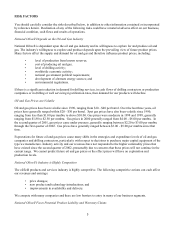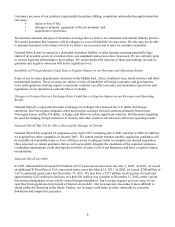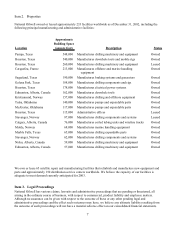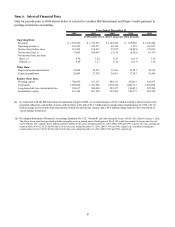National Oilwell Varco 2002 Annual Report Download - page 17
Download and view the complete annual report
Please find page 17 of the 2002 National Oilwell Varco annual report below. You can navigate through the pages in the report by either clicking on the pages listed below, or by using the keyword search tool below to find specific information within the annual report.Interest Rate Risk
Our long term borrowings consist of $150 million in 6.875% senior notes, $150 million in 6.5% senior notes and
$200 million in 5.65% senior notes. We also have borrowings under our other facilities totaling $94.6 million at
December 31, 2002. A portion of the borrowings are denominated in multiple currencies which could expose us to
market risk with exchange rate movements. These instruments carry interest at a pre-agreed upon percentage point
spread from either the prime interest rate, LIBOR or NIBOR. Under our credit facilities, we may, at our option, fix
the interest rate for certain borrowings based on a spread over LIBOR or NIBOR for 30 days to 6 months. Based
upon our December 31, 2002 borrowings under our variable rate facilities of $94.6 million, an immediate change of
one percent in the interest rate would cause a change in annual interest expense of approximately $0.9 million. Our
objective in maintaining a portion of our debt in variable rate borrowings is the flexibility obtained regarding early
repayment without penalties and lower overall cost as compared with fixed-rate borrowings.
Critical Accounting Policies and Estimates
The preparation of our financial statements requires us to make certain estimates and assumptions that affect the
amounts reported in the financial statements and accompanying notes. Our estimation process generally relates to
potential bad debts, obsolete and slow moving inventory, value of intangible assets, and deferred income tax
accounting. Note 1 to the consolidated financial statements contains the accounting policies governing each of these
matters. Our estimates are based on historical experience and on our future expectations that we believe to be
reasonable under the circumstances. The combination of these factors result in the amounts shown as carrying
values of assets and liabilities in the financial statements and accompanying notes. Actual results could differ from
our current estimates and those differences may be material.
We believe the following accounting policies are the most critical in the preparation of our consolidated financial
statements:
We maintain an allowance for doubtful accounts for accounts receivables by providing for specifically identified
accounts where collectibility is doubtful and a general allowance based on the aging of the receivables compared to
past experience and current trends. A majority of our revenues come from drilling contractors, independent oil
companies, international oil companies and government-owned or government-controlled oil companies, and we
have receivables, some denominated in local currency, in many foreign countries. If, due to changes in worldwide
oil and gas drilling activity or changes in economic conditions in certain foreign countries, our customers were
unable to repay these receivables, additional allowances would be required.
Allowances for inventory obsolescence are determined based on our historical usage of inventory on-hand as well
as our future expectations related to our substantial installed base and the development of new products. The
amount reserved is the recorded cost of the inventory minus its estimated realizable value. Changes in worldwide
oil and gas drilling activity and the development of new technologies associated with the drilling industry could
require additional allowances to reduce the value of inventory to the lower of its cost or net realizable value.
Business acquisitions are accounted for using the purchase method of accounting. The cost of the acquired
company is allocated to identifiable tangible and intangible assets based on estimated fair value, with the excess
allocated to goodwill. On at least an annual basis, we assess whether goodwill is impaired. Our annual impairment
tests are performed at the beginning of the 4th quarter of each year. If we determine that goodwill is impaired, we
measure that impairment based on the amount by which the book value of goodwill exceeds its implied fair value.
The implied fair value of goodwill is determined by deducting the fair value of a reporting unit's identifiable assets
and liabilities from the fair value of that reporting unit as a whole. Additional impairment assessments may be
performed on an interim basis if we encounter events or changes in circumstances that would indicate that, more
likely than not, the carrying amount of goodwill has been impaired. The fair value of the reporting units is
determined based on internal management estimates that considers multiple valuation techniques.
15
























